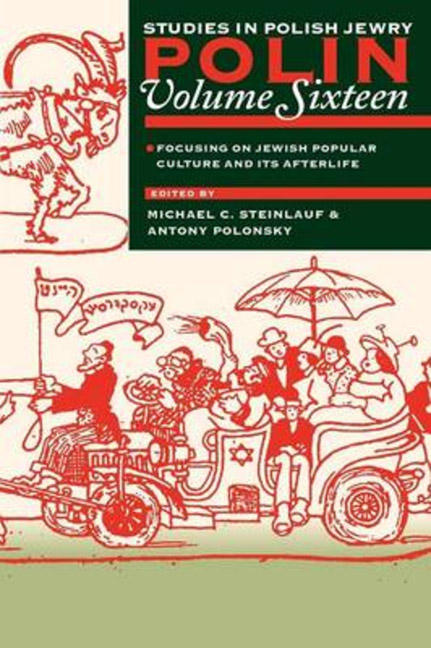Book contents
- Frontmatter
- Dedication
- Editors and Advisers
- Preface
- Polin
- Polin: Studies in Polish Jewry
- Contents
- Note on Place Names
- Note on Transliteration
- PART I JEWISH POPULAR CULTURE IN POLAND AND ITS AFTERLIFE
- IN PRE-WAR POLAND
- AFTERLIFE
- PART II DOCUMENTS
- PART III NEW VIEWS
- PART IV REVIEWS
- REVIEW ESSAYS
- Some Remarks on Leszek Hońdo's Study of the Old Jewish Cemetery in Kraków
- The Last Controversy over Ritual Murder? The Debate over the Paintings in Sandomierz Cathedral
- The Anti-Zionist Campaign in Poland of 1967–1968: Documents
- BOOK REVIEWS
- CORRESPONDENCE
- OBITUARIES
- Notes on the Contributors
- Glossary
- Index
Some Remarks on Leszek Hońdo's Study of the Old Jewish Cemetery in Kraków
from REVIEW ESSAYS
- Frontmatter
- Dedication
- Editors and Advisers
- Preface
- Polin
- Polin: Studies in Polish Jewry
- Contents
- Note on Place Names
- Note on Transliteration
- PART I JEWISH POPULAR CULTURE IN POLAND AND ITS AFTERLIFE
- IN PRE-WAR POLAND
- AFTERLIFE
- PART II DOCUMENTS
- PART III NEW VIEWS
- PART IV REVIEWS
- REVIEW ESSAYS
- Some Remarks on Leszek Hońdo's Study of the Old Jewish Cemetery in Kraków
- The Last Controversy over Ritual Murder? The Debate over the Paintings in Sandomierz Cathedral
- The Anti-Zionist Campaign in Poland of 1967–1968: Documents
- BOOK REVIEWS
- CORRESPONDENCE
- OBITUARIES
- Notes on the Contributors
- Glossary
- Index
Summary
FOR CENTURIES the old Jewish cemetery in Kraków has attracted the special attention of researchers on Jewish antiquity and pious pilgrims to holy grave sites, as well as ordinary travellers and the simply curious. Recently, the need for a detailed inventory of the grave sites has become ever more urgent, particularly with the pace of erosion of the headstones. Following the publication by earlier historians of several incomplete descriptions of the cemetery in Kraków, Leszek Hońdo took a full inventory between 1994 and 1997. On the basis of this work he has published a volume entitled Stary żydowski cmentarz w Krakówie: Historia cmentarza, analiza hebrajskich inskrypcji (‘The Old Jewish Cemetery in Kraków: History of the Cemetery with Analysis of the Hebrew Inscriptions’).
Hońdo's work was intended as a general introduction to the full inventory of Kraków's old Jewish cemetery. It consists of three chapters (with an introduction and summary) dealing respectively with the history of the cemetery, the current state of research on the cemetery, and general characteristics of the inscriptions. The last chapter is by far the longest and discusses the language of the inscriptions, the formulaic structure of epitaphs, abbreviations, and the connection between the text and images on the gravestones. The section entitled ‘The Formulaic Structure’ constitutes a third of the whole book. It deals with many issues beyond the subject of structure, addressing elements of style, the deceased's titles, identifiers (names, nicknames, works, patronymics), forms of presenting data, and formulaic elements on the epitaphs. The book is interspersed with samples of inscriptions, with a photograph, transcription and translation of the epitaph, sometimes a short description of the tombstone, and a discussion of other places where it is described. At the end of the book are a list of references, sketch map of the cemetery, and index.
We have many reservations about this volume, beginning with its conceptualization and composition and ending with the orthography and editorial analysis. In writing this review, however, our purpose is not so much to list the mistakes evident in this particular work, but rather to discuss the wider methodological issues arising in the analysis and description of Jewish cemeteries.
- Type
- Chapter
- Information
- Focusing on Jewish Popular Culture and Its Afterlife , pp. 467 - 482Publisher: Liverpool University PressPrint publication year: 2003



